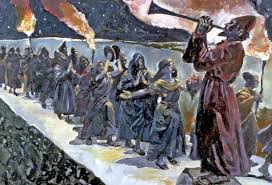The Completion of the Walls Despite Opposition
Nehemiah 6: 1-19
445 BC During the ministry of Nehemiah (see Bt – The Third Return).
Compiled by: The Chronicler from the Ezra and Nehemiah Memoirs
(see Ac – Ezra-Nehemiah From a Jewish Perspective: The Nehemiah Memoirs).

After dealing with the internal difficulties arising from economic inequities, Nehemiah returns to the personal problems brought on by the persistent attempts of his enemies to stop the work of rebuilding the walls of Jerusalem. The work on the wall had reached a crucial stage and was almost complete. Failing in every previous attempt to halt the work, Sanballat and his evil allies determined that the final solution would be to murder Nehemiah, either outside the City (see Ci – Attempts to Snare Nehemiah), or inside the Temple (to see link click Cj – The Hiring of False Prophets). However, despite all their efforts, even with inside help, the wall was completed with the help of ADONAI’s strength and the people’s courage (see Ck – The Completion of the Walls).254
In this study, we have focused on the positive leadership qualities of Nehemiah. But there is also much to be learned from another perspective. Here are ten fatal flaws that derail those who think they are in charge:
Poor leadership in good times can be hidden, but poor leadership in bad times is a recipe for disaster. To find out why leaders fall a recent study was done scrutinizing results from two studies: In one, 360-degree feedback data was collected on more than 450 Fortune 500 executives and then teased out the common characteristics of the 31 who were fired over the next three years In the second, 360-degree feedback data was analyzed from more than 11,000 leaders and identified the ten-percent who were considered least effective. Comparing the ineffective leaders with the fired leaders, the study came up with the ten most common leadership shortcomings. Every bad leader had at least one, and most had several.
The worst leaders:
Lack energy and enthusiasm. They see new initiatives as a burden, rarely volunteer, and fear being overwhelmed. One such leader was described as having the ability to “suck all the energy out of any room”
Accept their own mediocre performance. They overstate the difficulty of reaching targets so that they look good when they achieve them. They live by the mantra, “Under promise and over deliver.”
Lack clear vision and direction. They believe their only job is to execute. Like a hiker who sticks close to the trail, they’re fine until they come to a fork.
Have poor judgment and put personal rivalries ahead of the organization’s best interests.
Don’t collaborate. They avoid peers, act independently, and view other leaders as competitors. As a result they are set adrift by the very people whose insights and support they need.
Don’t walk the talk they set standards of behavior or expectations of performance and then violate them. They’re perceived as lacking integrity.
Resist new ideas they reject suggestions from subordinates and peers. Good ideas aren’t implemented, and the organization gets stuck.
Don’t learn from mistakes. They may make no more mistakes than their peers, but they fail to use setbacks as opportunities for improvement, hiding their errors and brooding about them instead.
Lack interpersonal skills. They make sins of both commission (they ‘re abrasive and bullying) and omission (they’re aloof. unavailable, and reluctant to praise).
Fail to develop others, they focus on themselves to the exclusion of developing subordinates, causing individuals and teams to disengage.
These sound like obvious flaws that any leader would try to fix. But the ineffective leaders that were studied were often unaware that they exhibited these behaviors. In fact, those who were rated most negatively rated themselves substantially more positively. Leaders should take a very hard look at themselves and ask for candid feedback on performance in these specific areas. Their jobs may depend on it.



Leave A Comment